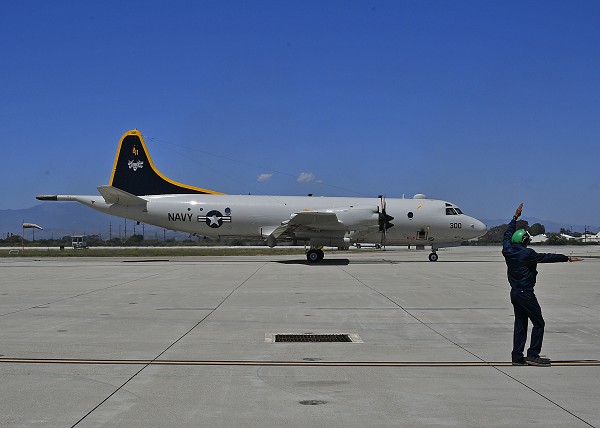 POINT MUGU, Calif. (May 11, 2022). In this photo by Ensign Drew Verbis, a P-3 Orion maritime patrol aircraft assigned to Air Test and Evaluation Squadron 30 completes its landing during the final flight of Cmdr. Jason Saglimbene, commanding officer onboard Naval Base Ventura County. Cmdr. Saglimbene, a native of Wyckoff, New Jersey, graduated from the United States Naval Academy in May 2002 and earned his Naval Aviator wings in August 2003.
POINT MUGU, Calif. (May 11, 2022). In this photo by Ensign Drew Verbis, a P-3 Orion maritime patrol aircraft assigned to Air Test and Evaluation Squadron 30 completes its landing during the final flight of Cmdr. Jason Saglimbene, commanding officer onboard Naval Base Ventura County. Cmdr. Saglimbene, a native of Wyckoff, New Jersey, graduated from the United States Naval Academy in May 2002 and earned his Naval Aviator wings in August 2003.
POINT MUGU, Calif. (May 11, 2022): They lurk beneath the waves carrying a deadly cargo, including nuclear missiles that could end civilization. Their mission is to approach by stealth, remain undetected, and then launch their missiles to devastating effect. They are enemy submarines, and they pose the ultimate threat to American civilians and military alike.
Part of America’s response to this threat is the PC-3 Orion, a four-engine turboprop aircraft used by the U.S. Navy to locate and track enemy submarines. Originally deployed in the late 1960s, the P-3C Orion has undergone a series of system upgrades to improve its ability to detect modern threats undersea and on land. Just like the famous B-52 bomber, the P-3 Orion was in service long before their pilots and crews were born.
The Orion is a large aircraft, 120 feet long with a one-hundred-foot wingspan, It has four turboprop engines that can keep it aloft for up to 14 hours and has a range of 2,380 nautical miles. It has a crew complement of eleven, including three pilots, two naval flight officers, two flight engineers, three sensor operators, and one in-flight technician. This bird is designed for large payloads, capable of carrying up to 15,000 pounds, and cruises at speeds of four hundred knots and altitudes up to 28,000 feet. But what is most impressive about the P-3 Orion is the variety of missions it performs, both as a flying listening device and as an attack platform.
Built by Lockheed Martin Aeronautical Systems, the Orion has a distinctive tail stinger or "MAD" boom (short for magnetic anomaly detection) lowered from the rear of the aircraft and dragged below the surface to search for enemy subs. Additionally, the P-3 carries 129 sonobuoys that bracket underwater targets using its sophisticated software. Its avionics system includes a general-purpose digital computer supporting its tactical displays, and the Orion can launch its weapons automatically while guiding pilots to their targets.
Over the years, the Navy modified the Orion to serve as a weapons platform, capable of launching Harpoon and Maverick missiles, torpedoes, rockets, mines, and depth bombs. The Navy plans to replace the P-3 Orion with the P-8A Poseidon jet aircraft in the near future. Currently, the P-3 is in service in navies and air forces around the world.
At Support Our Troops, our mission is to provide comfort items for our active duty servicemembers, like the highly skilled crews on the Orion. Currently, we have issued a national call to help us ship Yellow Ribbon Care Packages to the troops this holiday season. We give these troops “what they need, where they need it” with donations from patriotic Americans, like you. Won’t you take a moment, right now, to help us send the troops a piece of home this holiday season. Please visit our secure website https://supportourtroops.org/donate to donate to America’s finest today!


